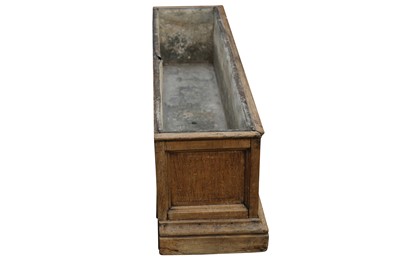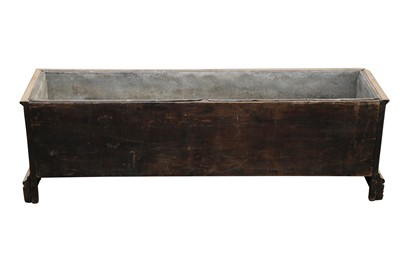3rd Nov, 2021 11:00
A Middle Eastern Journey
A FLOWER TROUGH INSET WITH 'PERSIAN' DESIGN MINTON POTTERY TILES
Minton, Hollins & Co, Stoke-upon-Trent, England, late 19th - early 20th century
A FLOWER TROUGH INSET WITH 'PERSIAN' DESIGN MINTON POTTERY TILES
Minton, Hollins & Co, Stoke-upon-Trent, England, late 19th - early 20th century
Comprising 6 dust-pressed tiles, set into a rectangular oak flower trough, with a stepped bottom rim and stepped square panels to each end, a removable zinc insert with a short drainage pipe, the tiles decorated in an Iznik-style pattern featuring a poly-lobed cartouche framing an arabesque with lotus flowers and split palmettes, the design commonly referenced as a Minton 'Persian' design, and coloured in cobalt blue and turquoise with gilt outlines over black all on white ground, the back of the tiles moulded with a grid pattern (to help the tiles grip to a fixing mixture like cement), moulded in between the grids the company name and 'patent tile works Stoke on Trent', the tiles approx. 20cm x 20cm, the zinc insert 123cm long x 26cm deep x 27.5cm high, the trough 136cm long x 33.5cm deep x 42.5cm high.
Herbert Minton (1793 - 1858) was instrumental in developing the large-scale manufacturing process of ceramics production in England. Expanding from tableware and ornamental ceramics into tile work in the 1830s, Minton recognised the great potenial of applying Richard Prosser's designs for a dust-pressing button manufacturing method, to the ceramics industry. He also recognised and encouraged the developement of image transfer design, and forsaw the popularity of encaustic tiles in the English market (red-brown clay floor tiles impressed with lighter colour ornamental designs). As one of the leading and most dominant manufacturing powers at the time, Minton & Co's design repotoire included Gothic and Classical designs as well as those inspired by the Turkish kilns of Iznik (H. van Lemmen, 5000 Years of Tiles, 2013, p. 164 - 176).
A watercolour design similar to the one seen on our tiles exists in The Minton Archive and dates to ca. 1850 - 1900. Along with it are studies of true Iznik tiles as well as other architectual designs and designs for ornamental pieces and vessels (accession number SD 1705/MS1798). The Minton Archive is a sub-collection within the Royal Doulton plc archive collection and is availble at the Stoke-upon-Trent City Archives, for more information please visit their website https://www.themintonarchive.org.uk/about/. Patent registrations for Flower Troughs also exist within the archive and are dated to March 1870 (accession number SD 1705/MS795), suggesting production taking place at a similar time.
Herbert Minton died in 1858, resulting in his nephews forming a partnership to continue the company. This partnership was dissolved 1868, with Michael Daintry Hollins continuing the company under the new name Minton, Hollins & Co. The other nephew Colin Minton Campbell and the two nephew's previous partner, Robert Minton Tyler, set up a new rival company, known under three names over the years: Minton Brick & Tile Co, Campbell Brick & Tile Co and finally Campbell Tile Co (H. van Lemmen, 5000 Years of Tiles, 2013, p. 169). Minton, Hollins & Co continued independently producing until 1968 when they merged with Royal Doulton.
Iznik and so called 'Persian' designs were not a major feature of Minton's (or the different companies') design repoirtoire, but this being so is arguably an indication of the vast influence and degree of inspiration ceramics from Islamic lands had on Western production and design trends throughout the 1800 and 1900s.
Sold for £500
Includes Buyer's Premium
Do you have an item similar to the item above? If so please click the link below to submit a free online valuation request through our website.







